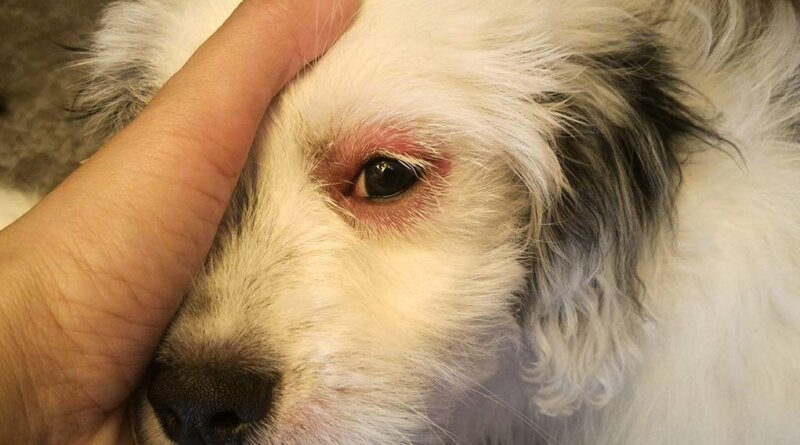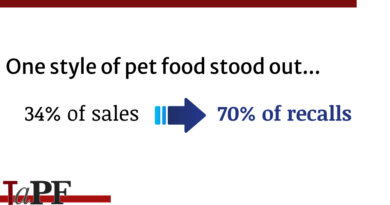Here’s Why and What to Do
Most days you look into your dog’s soulful eyes, and wonder what your friend is thinking. There is no question that much of your pup’s expressiveness lies there. But one day, you look into them, and the eyes don’t seem right – they’re reddish.
A dog’s eyes are much like human ones: when they’re healthy, they look bright and clear. When something is wrong, your pet’s eyes may look pink or ruddy, which are usually signs of irritation. This isn’t comfortable for your pooch. So now you’re asking yourself, my dog has red eyes, what’s going on? Here’s what it could be.
Causes of Red Eyes in Dogs
There are several culprits that could result in red eyes in dogs.
1. Allergy
Your dog may experience seasonal allergies which results in red eyes caused by the environment or, in some cases, brought on by diet.
The best way to tackle this is by tracking when a dog has a red-eye outbreak. If it’s only during a specific part of the year, then simple dog eye drops like Nutri-Vet will help to relieve eye redness in your dog. If it’s year-long or a food related allergic reaction, it will take longer to figure out the culprit, and you will need to discuss this with a vet.
2. Cherry Eye
If you see a bulge of pink, usually near the corner of the eye closest to the dog’s nose, this is likely a condition called Cherry Eye.
Dogs have a third eyelid that you can’t normally see. This pops out in animals who have weak ligaments holding that lid in place.
Certain breeds have a propensity toward Cherry Eye, such as:
- Beagles
- Bloodhounds
- Bulldogs
- Cocker Spaniels
- Lhasa Apsos
- Maltese
- Poodles
- Pugs
- Shih Tzus
The usual treatment for Cherry Eye in dogs is surgery on the third eyelid because the gland there produces about half of your dog’s tear film. Without this, your dog can move into dry eye, which impairs a dog’s vision over time.
Most dogs recover from Cherry Eye surgery within a few weeks.
3. Corneal Damage
Anything that damages a dog’s cornea can cause red eyes due to irritation. For example, if a dog’s eye gets poked with some weed or gets scratched by a persnickety cat.
Corneal damage in dogs typically heals in about three days. You may have to administer antibiotic eye drops (prescribed by a veterinarian) for pain and to prevent potential eye infection.
4. Dry Eyes
Dry eyes are fairly common in canines. When your dog’s eyes don’t produce enough tears to keep them moist, it also increases the chance of unwanted agents entering them.
If it’s dry eyes that’s causing redness, your veterinarian will typically prescribe a special eye drop that not only soothes the eye and improves tear production in your pooch, but also washes out any bits of debris or treat an infection.
5. Glaucoma
Glaucoma is a fluid build up in your dog’s eye, which, over time, can lead to blindness. If this is the case, the dog’s eyes may also look swollen. This is a very serious condition that requires vet attention as soon as you notice symptoms.
6. In-Grown Eyelids (Entropion)
In the case of Entropion in dogs, your pet’s eyelids roll inward and cause them discomfort. It also can result in damage. Breeds commonly susceptible to this include:
- Akita
- American Strafford Terrier
- Basset Hound
- Bloodhound
- Bulldog
- Dalmatian
- Great Dane
- Great Pyrenees
- Irish Setter
- Mastiff
- Old English Sheepdog
- Pomeranian
- Shar-Pei
- Spaniel
- Rottweiler
This condition requires surgical correction.
7. Pink Eye
Also known as conjunctivitis, Pink Eye in dogs occurs when the inner eyelid becomes inflamed. You see this as pinkness. Conjunctivitis may be contagious to other pets, particularly if it is bacterial based. Treatments include artificial tears, steroid eye drops, and cool eye compresses when your dog is resting.
Many times your dog’s red eyes is a temporary reaction to some type of irritation. However, red eyes can indicate underlying medical problems like diabetes or hyperthyroidism. Symptoms that imply something more is going on include:
- Constant eye-watering
- Discharge (yellow or green)
- Mucus discharge
- Rubbing of their eyes on furniture
- Squinting or frequent blinking
Take note of these and tell your veterinarian.
Diagnosis of Red Eyes in Dogs
When you take your pet to the vet for red eye symptoms, what can you expect? The exact diagnosis of red eye in dogs depends on what your vet expects but here are a few things that happen:
Blood Tests: A blood screening can detect underlying illnesses that result in eye redness and irritation.
Detailed Eye Exam: This way the vet knows exactly what part of your pup’s eyes are red. Your vet may track your dog’s vision and examine the structure of your dog’s eye.
Fluorescent Eye Drops: These reveal corneal scars or scratching.
Internal Pressure: A Tonometer reads the pressure of your dog’s eye in order to rule out Glaucoma.
Schirmer Tear Test: This measures tear production. The test consists of small strips of paper held in the dog’s lower eyelid. Your dog may fuss a bit, but it’s not painful. During this test, your vet may collect some resulting fluid and check it for bacteria.
Treatment Instructions: Make sure your vet tech shows you how to administer any medications recommended, such as how to apply eye ointment or drops.
If it turns out that there is a serious cause for your dog’s red eyes, you may have to go to a specialist for further examination and treatment.
How to Keep a Dog’s Eyes Healthy
Start by paying close attention to your dog’s eyes regularly. Look for any signs of discharge or crusting. The area around the eyeball should be white and bright. Any change in color, cloudiness, or uneven pupils means a vet visit is in order.
Even the tidiest of dogs will sometimes have eye gunk or eye boogers in the corner of their eye. Clean this out gently using a damp cotton ball. While you are there, take a look at the lining of your canine’s eyelid. It should be pink, not red or white.
If you have a long-haired dog, keep the fur away from their eyes, and make sure that area remains well-groomed. Those long hairs can scratch your dog’s eyes.
For dogs who love to travel with their head out the car window, get dog goggles. The wind can bring all types of debris with it, injuring your dog’s eyes.
Last but not least, keep your eyes on your dog’s behavior and appearance, and have your vet conduct annual eye exams.
READ NEXT: 9 Most Common Dog Eye Problems (How to Prevent and Treat Them)




doxycycline mono – https://doxycyclinesale.pro/#
over the counter arthritis medicine https://overthecounter.pro/#
wellcare over the counter ordering: humana over the counter over the counter stocks
mail order pharmacy india https://indianpharmacy.pro/#
Immerse yourself in the colorful world of taste with our bespoke collection of [url=https://velo1.ink/]velo[/url] flavors. Be inspired!
buy crestor generic order zetia 10mg for sale buy motilium for sale
dark market 2023 blackweb official website
mens ed pills https://edpills.ink/# – buying ed pills online
buy cytotec https://cytotec.ink/# – buy misoprostol over the counter
erection pills that work https://edpillsotc.store/# – ed treatment drugs
world pharmacy india https://indianpharmacy.life/# – reputable indian pharmacies
indian pharmacies safe: best online pharmacy india legitimate online pharmacies india
buy clopidogrel online https://plavix.guru/ Cost of Plavix without insurance
best price for viagra 100mg https://viagra.eus/# Sildenafil Citrate Tablets 100mg
Dear immortals, I need some wow gold inspiration to create.
mexican mail order pharmacies https://mexicanpharmacy.company/# best mexican online pharmacies mexicanpharmacy.company
Unleash the gamer in you with our immersive online games. Hawkplay
hxjglobal.com Radial Plunger Pump hxjglobal.com.
Immerse yourself in a symphony of sights and sounds. Lucky Cola
order minocycline 100mg buy minocycline 50 mg stromectol for head lice stromectol.guru
Certains logiciels détectent les informations d’enregistrement d’écran et ne peuvent pas prendre de capture d’écran du téléphone mobile. Dans ce cas, vous pouvez utiliser la surveillance à distance pour afficher le contenu de l’écran d’un autre téléphone mobile. https://www.xtmove.com/fr/how-view-the-screen-content-another-phone/
can you buy prednisone over the counter https://prednisonepharm.store/ prednisone best price
indian pharmacy paypal https://medicinefromindia.store/ reputable indian online pharmacy
You can also customize monitoring for certain apps, and it will immediately start capturing phone screen snapshots regularly.
canadian pharmaceuticals canadian pharmacies online
generic cialis online pharmacy [url=http://canadianphrmacy23.com/]Canadian Pharmacies canadianphrmacy23.com[/url]
canada pharmacies online prescriptions click here to read
generic pharmacy india [url=http://canadianphrmacy23.com/]canadian pharmacy[/url]
cheap cialis online canadian pharmacy cialis online pharmacy
viagra pharmacy online [url=http://canadianphrmacy23.com/]pop over to these guys[/url]
canadian-pharmacy-online Canadian Pharmacy
pharma from canada [url=http://canadianphrmacy23.com/]cialis pharmacy[/url]
canadian pharmacy meds best online canadian pharmacies
northwestpharmacy [url=http://canadianphrmacy23.com/]canadian pharcharmy online without prescription[/url]
canadianpharmacymeds.com try here
canadian pharmacy no prescription [url=http://canadianphrmacy23.com/]canadianphrmacy23.com[/url]
online pharmacies canada costco pharmacy
canada rx pharmacy [url=http://canadianphrmacy23.com/]what is it worth[/url]
online pharmacy usa canada pharmacy for cialis
onlinepharmaciescanada.com [url=http://canadianphrmacy23.com/]http://canadianphrmacy23.com/[/url]
canadian pharmacies shipping usa discount canadian pharmacies
india pharmacy [url=http://canadianphrmacy23.com/]Canadian Pharmacy[/url]
the canadian pharmacy Canadian Pharmacy Online to Usa canadianphrmacy23.com
cialis from usa pharmacy [url=http://canadianphrmacy23.com/]best canadian pharmacies shipping to usa[/url]
diflucan online prescription https://diflucan.pro/ can you buy diflucan over the counter in mexico
eva elfie videos https://evaelfie.site/ eva elfie
jogo de aposta – https://jogodeaposta.fun/ jogo de aposta online
pin-up bonanza: https://pinupgiris.fun/ pin up casino giriş